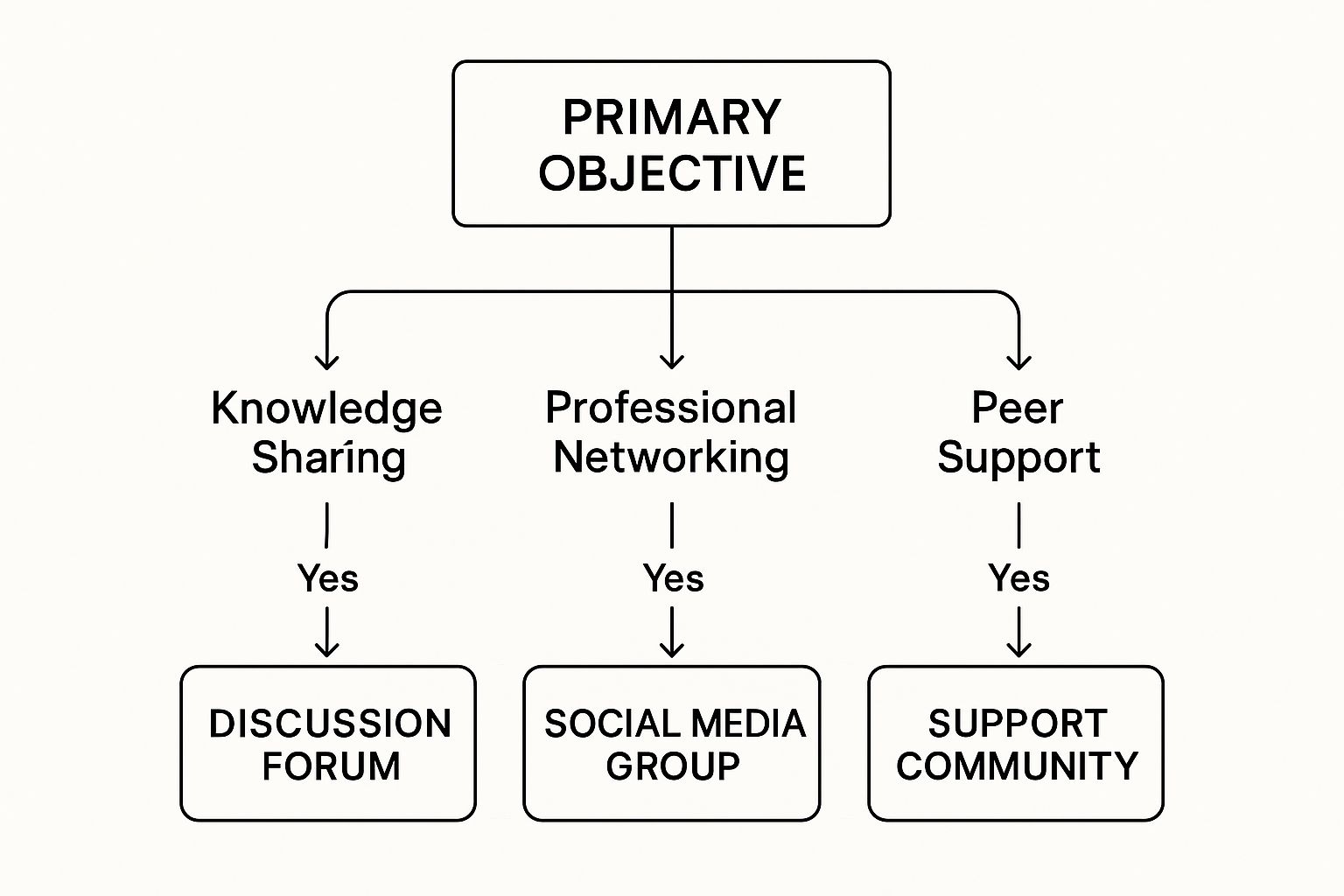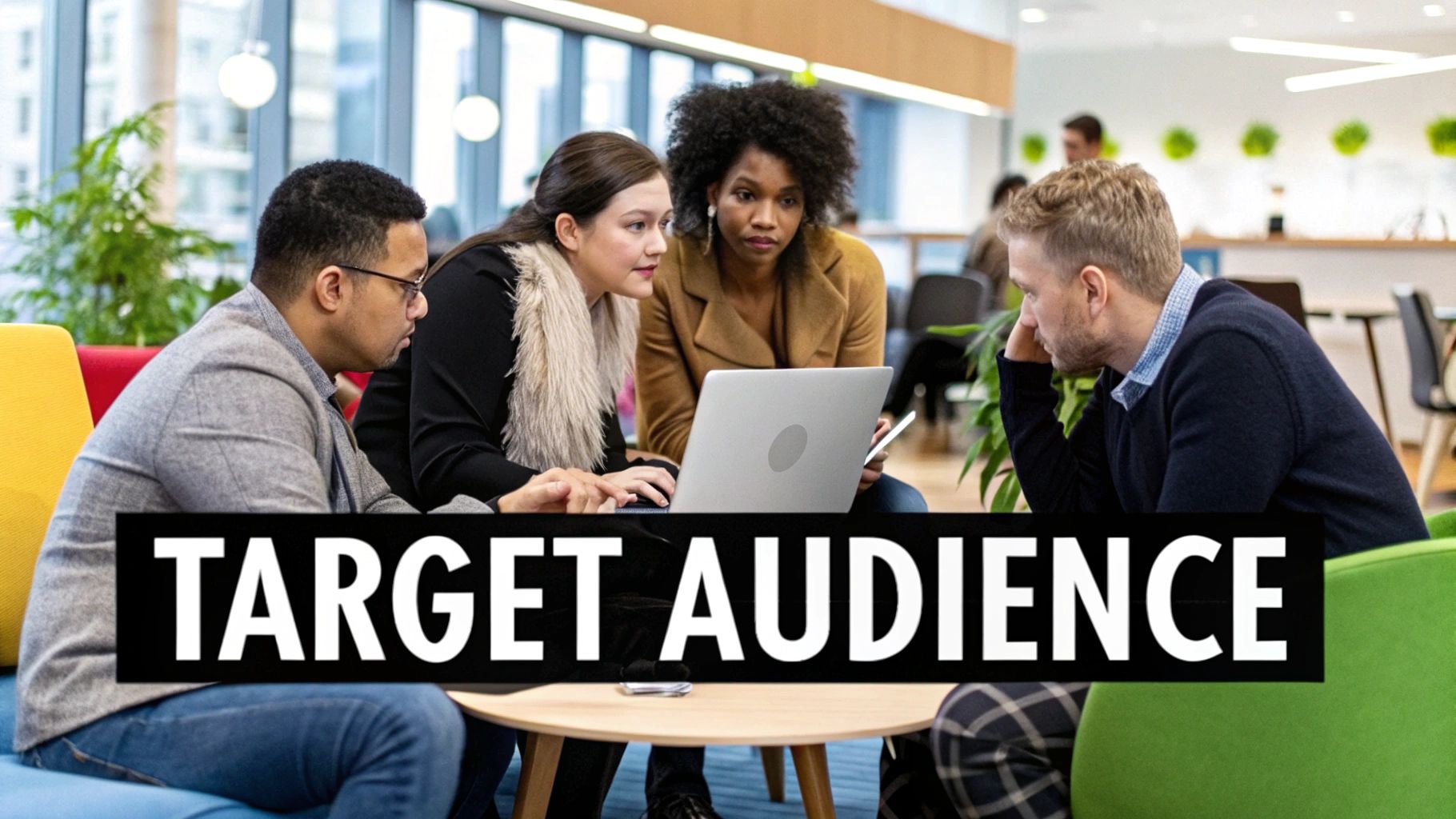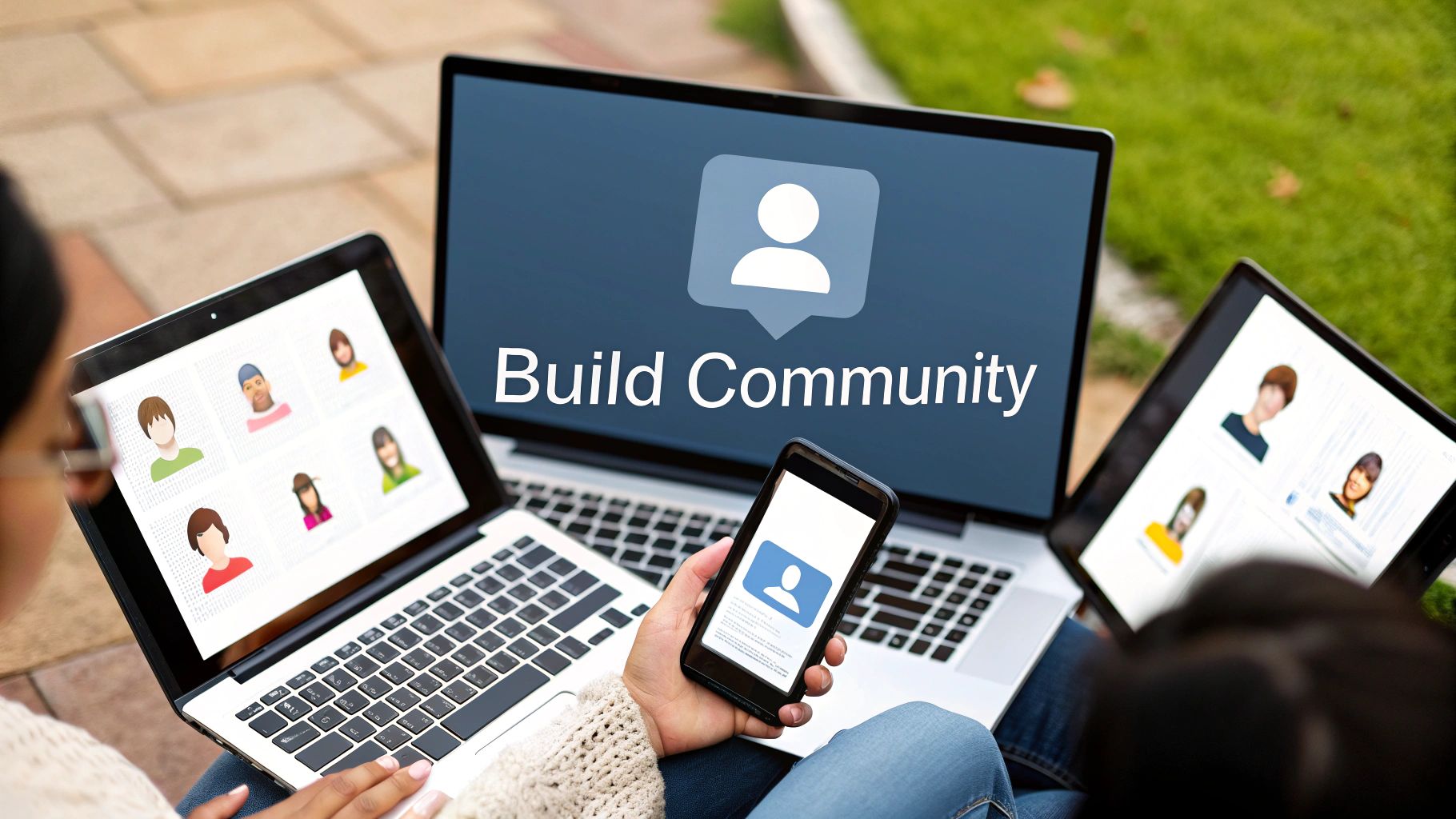Before you can even think about building an online community, you have to get the foundation right. This isn't just about picking a platform and sending out invites; it's the strategic work that separates a thriving, self-sustaining community from one that fizzles out in a few months.
Laying the Groundwork for Your Community
Let’s be honest: a successful community doesn't happen by accident. It’s the direct result of smart, deliberate decisions made long before your first member joins. This is where you move from a vague idea to the concrete choices that will define your community’s entire future.
You need to get crystal clear on its reason for being. Are you trying to cut down on support tickets? Create a space for networking? Or is this about getting raw, honest product feedback? Each of those goals requires a totally different playbook.
Define Your Community's Core Purpose
First things first: you need to anchor your community to one primary goal. Without a clear "why," people have no real reason to show up, let alone stick around. Is your community going to be a:
- Support Hub: A place where users can help each other out, find answers, and ultimately lighten the load on your formal support team.
- Networking Space: A professional hub for people to connect, talk shop, share opportunities, and build real relationships within your niche.
- Feedback Engine: A direct line to your most passionate users. This is where you can gather insights, float new ideas, and essentially co-create your product roadmap with the people who use it most.
Think of your community's purpose as its north star. It should guide every single decision you make, from the platform you choose to the content you post. If an activity doesn't serve that core purpose, it's just noise.
This thought process directly impacts the kind of community you should build.

As you can see, your main objective should dictate the entire structure of the community. It’s the only way to make it truly effective.
Pinpoint Your Ideal Member
Once you’ve nailed down your "why," you have to figure out your "who." A vague target like "all of our customers" is a recipe for failure. It's simply too broad.
You need to get specific and build a detailed profile of the person this community is for. What really motivates them? What problems are they struggling with? More importantly, what can they get from a group setting that they can't find anywhere else? For a SaaS company, this might be a power user looking for advanced tricks or a brand-new user who just needs a bit of encouragement to get started.
Choose the Right Platform
Where your community will live is one of the most critical decisions you'll make. You can either build on a dedicated platform or piggyback on an existing ecosystem people already use. Both paths have some serious pros and cons.
The rise of remote work has made platforms like Slack, Discord, and Microsoft Teams the default for online interaction. Their convenience has set a really high bar. That means if you're a smaller brand, you have to offer a truly compelling reason for someone to sign up for yet another platform instead of just joining a Slack channel.
This new reality makes the platform choice more strategic than ever. If you want to dig deeper into this planning stage, our guide on how to build an online community is a great resource.
To help you decide, let's break down the key factors.
Choosing Your Community Platform
The choice between a custom, branded space and a familiar, ready-made one comes down to a few key trade-offs.
| Factor | Dedicated Platform (e.g., Circle, Mighty Networks) | Existing Ecosystem (e.g., Slack, Discord) |
|---|---|---|
| Control & Branding | You have full control over the look, feel, features, and user data. It's a true extension of your brand. | Customization is limited. Your community lives inside another company's world. |
| Friction for Users | There's higher friction. People have to create a new account and learn a new interface. | It's low friction. Your members are likely already on the platform, making it a breeze to join. |
| Data & Analytics | You get rich, integrated analytics that provide deep insights into member behavior and engagement. | Analytics are often basic. You might need third-party tools to get any meaningful data. |
| Cost | Usually involves a monthly subscription fee that can grow as your community does. | Often has a generous free tier, but you'll have to pay for advanced features and larger teams. |
Ultimately, your choice boils down to your priorities. If deep integration, owning your data, and a seamless brand experience are non-negotiable, a dedicated platform like Circle or Mighty Networks is the way to go. But if you need to get up and running fast and want the lowest possible barrier to entry, an existing ecosystem is probably your best bet.
Launching and Attracting Your First Members

How you launch your community will echo for months. It sets the tone for the culture, the energy, and the growth you'll see down the line. A great rollout isn't about throwing the doors wide open all at once. It’s a carefully staged process designed to build momentum right from day one.
From my experience, the most powerful strategy is a soft launch. This means you hand-select a small, core group of founding members to get the ball rolling. Think of it like a preview night for a play—it’s your chance to fix any issues, spark those first conversations, and build a welcoming vibe before the big public reveal.
This initial crew is your cultural bedrock. They are the people who will help you create the positive, helpful environment you've been dreaming of. Choose them wisely.
Curating Your Founding Members
Your ideal founding members aren't just random customers. You're looking for people who are already bought into your brand or mission. This group sets the initial vibe for everyone who follows, so being deliberate here is non-negotiable.
So, who are these people? Look for individuals who are:
- Active and Engaged: These are the folks already commenting on your blog, replying to your newsletters, or chatting with you on social media. They're already raising their hands.
- Power Users: For any SaaS product, these are the customers who live and breathe your platform. They know it inside and out and are probably already helping other users in unofficial ways.
- Constructively Vocal: You want the people who give you thoughtful feedback—both the good and the bad. They care enough to want to see you get better.
- Industry Connectors: Think about the respected voices in your niche. Getting them involved lends instant credibility and can attract other high-quality members.
When you find them, reach out personally. Don't send a generic blast. Explain that you're building something special and that you'd be honored to have their perspective from the start. Make them feel like the partners they are. This personal touch is the foundation for building an online community that actually lasts.
Promoting Your Community for Growth
Once your founding members have started some conversations and the space feels lived-in, it’s time to open up a bit more. The goal now is to drive a steady stream of new, qualified members without overwhelming the culture you just started building.
Your best promotional tools are the ones you already have. Forget about finding a brand-new audience for a minute; start with the people who already know and trust you.
High-Impact Promotion Channels
| Channel | Actionable Tactic | Why It Works |
|---|---|---|
| Email List | Send a dedicated announcement to your list. Don't just say "join our community"—highlight the benefits, like exclusive content or direct access to your team. | This is your warmest audience. A study by the University of Michigan even showed customers often spend more after joining a brand's community. |
| In-App Notifications | If you're a SaaS company, use a subtle but clear banner or modal inside your app to invite users. Catch them while they're already engaged. | This makes joining completely frictionless. They're already in your world; this just invites them to go one level deeper. |
| Social Media | Run a multi-post campaign showing what life is like inside the community. Share testimonials from founders or a sneak peek of a great conversation. | This is pure social proof. It reaches followers who might not be on your email list, expanding your pool of potential members. |
| Website & Blog | Add clear calls-to-action (CTAs) to your site's header or footer and sprinkle them at the end of relevant blog posts. | This turns your existing website traffic into a consistent, passive funnel for new, highly-relevant members. |
The key takeaway here is to treat your launch not as a single event, but as the beginning of an ongoing campaign. You have to consistently showcase the value and activity inside the community to keep that flow of new members coming.
Designing a Welcoming Onboarding Flow
Getting people to click "join" is only half the job. If they land in a confusing or silent space, they’ll bounce and you'll likely never see them again. A solid onboarding process is what turns a curious visitor into an active, contributing member.
Your onboarding should do three things, fast:
- Make them feel seen: A personal welcome goes a long way. Tag new members in a dedicated welcome thread and encourage them to say hello.
- Show them the ropes: Clearly lay out the community's purpose and rules. A pinned "Start Here" or "Welcome" post is perfect for this.
- Give them a clear next step: Prompt them to do something simple. Ask them to fill out their profile, vote in a fun icebreaker poll, or, best of all, introduce themselves in a specific channel.
For instance, your automated welcome email could say, "Welcome, [Name]! So glad you're here. The best way to get started is to pop into our #introductions channel and tell us what you're working on!" This simple, direct prompt makes that first act of engagement feel easy and natural, dramatically increasing the chance they'll stick around.
Creating a Vibrant Member Experience
https://www.youtube.com/embed/dK3dJtxyA2E
Getting your community platform launched is a huge win, but let’s be honest—the real work starts the moment the doors open. An empty, silent community is a ghost town, and that's often worse than having no community at all. Your job now shifts from being a builder to an animator. You're the one who has to breathe life into the space and get the conversation started.
This is more than just posting a welcome message and moderating comments. It’s about orchestrating a consistent flow of valuable interactions that make people feel seen and heard. When you get it right, you'll spark a self-sustaining cycle where members start creating value for each other, not just for you.
Make it Personal
A one-size-fits-all approach is a recipe for a disengaged community. People today expect experiences that feel like they were made just for them. In fact, a recent study showed that 80% of consumers are more likely to buy from a brand that offers a personalized experience. This is why you see a big push towards hyper-personalization, where we use data to tailor everything from the onboarding flow to the content people see.
True personalization goes way beyond using a [first_name] tag in an email. It’s about understanding where your members are in their journey. For a SaaS product, this could mean having a dedicated channel for power users to nerd out on advanced workflows, while also offering a separate, judgment-free space for beginners to ask the "dumb" questions.
A personalized experience is the difference between a member feeling like they've walked into a generic conference hall versus a curated workshop designed just for them. The more relevant the experience, the more likely they are to stay and participate.
Design Engaging Community Programs
To build real momentum, you need a calendar of recurring events and content. These programs give people a reason to keep coming back and serve as the heartbeat of your community, creating predictable moments of connection.
Here are a few ideas that I've seen work time and time again:
- Member Spotlights: Find a super-active member and feature them. Share their story, their work, and why they’re such a great part of the group. This gives them well-deserved recognition and helps others put a face to a username.
- Expert Q&As: Bring in an industry expert—or even a senior person from your own team—for a live "Ask Me Anything" (AMA) session. This delivers a massive amount of value and cements your community's reputation as a go-to resource.
- Exclusive Content Drops: Give your community members early access to things like a new guide, a beta feature, or a research report before it's released to the public. This is a simple but powerful way to reward them for being part of the group.
- UGC Showcases: Actively encourage members to share what they're working on. You can then highlight the best submissions each week, which flips the script and turns members from passive lurkers into active creators.
A solid community engagement strategy will weave several of these ideas together to keep things fresh. Don't be afraid to experiment to see what your members truly respond to.
Identify and Empower Your Super-Users
In any community that starts to take off, a small group of highly engaged members will naturally surface. These are your "super-users," your "champions," your biggest fans. They’re the ones answering questions before you do, welcoming new folks without being asked, and giving you brutally honest feedback. They are gold.
Your job is to spot these people early and give them the tools to do more. Don't just sit back and watch their passion; actively cultivate it.
How to Empower Your Champions
- Give Them Recognition: Create a special badge or a unique title in the community (like "Community Leader" or "Product Guru") to publicly acknowledge their awesome contributions.
- Grant Them Privileges: Offer them early access to new features, invite them to private feedback sessions with the product team, or even grant them moderation rights.
- Create a Direct Line: Set up a private channel just for them. This creates a powerful advisory council and makes them feel like true insiders.
When you nurture these relationships, you're building a scalable peer-to-peer support system that not only deepens the community's value but also takes a huge load off your team. Mastering this also requires some solid people skills; exploring some remote team management tips can be surprisingly helpful for managing volunteer leaders and fostering a strong culture. This is how you transform your community from a top-down broadcast into a thriving, member-driven ecosystem.
Measuring Success and Proving ROI

Let's be real: for a community to survive inside a business, it has to pull its weight. It needs to deliver tangible, measurable value. It’s easy to get excited about watching the member count climb, but that’s often just a vanity metric.
The real challenge—and where you prove your worth—is showing how your community directly impacts core business goals. This is how you transform your community from a "nice-to-have" expense into an indispensable growth engine. To do that, you need a solid framework for tracking the Key Performance Indicators (KPIs) that your leadership team actually cares about.
Moving Beyond Vanity Metrics
The first mental shift you have to make is moving away from activity metrics and toward impact metrics. Sure, tracking likes, comments, and member growth is great for a daily health check, but it doesn't tell the whole story. You need to connect those dots directly to bottom-line results that make executives sit up and listen.
For SaaS and product-led companies, this usually means zeroing in on a few key areas:
- Slashing Support Costs: An active community where people help each other is one of the best ways to deflect support tickets. I’ve seen this firsthand; one software company managed to cut its support ticket volume by a whopping 28% just by getting its community off the ground.
- Speeding Up Product Adoption: Your community is the perfect place to onboard new users, share best practices, and help people get to that "aha!" moment faster. This directly fights churn.
- Boosting Customer Lifetime Value (LTV): Members who feel like they belong are fiercely loyal. They’re more likely to stick around, upgrade their plans, or buy more from you. One study even found that customers simply spend more after joining a brand's online community.
Building a business case for your community isn’t about fuzzy feelings; it’s about hard numbers. When you can walk into a meeting and say, "Our community reduced support costs by X%" or "sourced Y new feature ideas," you're speaking the language of business.
This isn’t just about tracking data; it’s a fundamental shift in how you approach measurement.
Building Your Community Dashboard
To keep track of all this and report back effectively, you need a central dashboard. This doesn't need to be some complex, custom-coded beast. A well-organized spreadsheet or a simple BI tool like Looker or Tableau can work wonders.
The secret is to choose KPIs that map directly to your primary business objectives. Think of it as your community's command center, a living document that shows progress and makes it dead simple to share wins with stakeholders.
Essential Community ROI Metrics
| Metric Category | Example KPI | How to Track It |
|---|---|---|
| Customer Support | Ticket Deflection Rate | Compare the number of questions answered within the community against the number of new support tickets. |
| Product & Feedback | Feature Ideas Sourced | Tag and count valuable product ideas from community threads that actually make it onto the product roadmap. |
| Sales & Retention | Member Conversion Rate | Use unique tracking links in community-exclusive offers or surveys to see how many members become paying customers. |
| Engagement & Health | Active Members vs. Total Members | This is a classic. Monitor the percentage of members who are actually posting, commenting, or reacting—not just lurking. |
By focusing on metrics like these, you can build a powerful story around how your community delivers a killer return on investment.
Don't Forget the Human Element
Numbers are essential for proving ROI, but they don't capture the magic. The real soul of a community lives in the qualitative stuff—the stories, the connections, and the sentiment that you'll never find in a spreadsheet.
Ignoring these human-centered metrics is a huge mistake. They add the color and context that make your quantitative data feel real and compelling.
Here’s how you can tap into that qualitative gold:
- Listen to the Vibe: Regularly check the community's pulse. Is the overall tone positive and helpful? Do people feel supported and heard? This is often called sentiment analysis.
- Hunt for Success Stories: Be a detective. Actively look for and document those moments when the community helped someone achieve a goal. Did they solve a complex problem? Land a new client? Feel less alone in their work?
- Just Ask! Use simple polls and open-ended questions. Ask members what they love most about the space and what you could do better. Their direct feedback is invaluable.
When you blend these powerful stories with your hard data, you create a complete and undeniable picture of your community’s impact. If you're running events as part of your community strategy, digging into proven strategies for measuring event ROI can give you even more firepower to strengthen your business case.
How to Scale Your Community Without Losing Its Soul

Growth is the ultimate sign of success for any community. But let's be honest, it's also the single biggest threat to the high-trust culture you've worked so hard to build. That cozy, living-room feel can quickly evaporate, leaving you with a noisy, impersonal stadium as you scale from hundreds to thousands of members.
The secret to navigating this challenge? You have to scale your systems before you scale your member count. It’s about building a resilient framework that can handle growth without diluting the very essence of what makes your community special. This is how you build a community that lasts.
Develop Robust Moderation Systems
In the early days, you can probably handle moderation on your own. But as you grow, that becomes completely unsustainable. To keep conversations constructive and safe, you’ll need to shift from being the sole moderator to becoming the architect of a multi-layered moderation system.
Your first move should be to empower your most trusted members. A volunteer moderator program is a fantastic way to scale your human oversight. Look for those super-users who already embody your community’s values—the ones who are consistently helpful and level-headed—and give them the tools and recognition they deserve.
At the same time, AI-powered tools can be a lifesaver. These tools can automatically flag spam, hate speech, and other obvious violations. This frees up your human moderators to focus on the more nuanced issues and, more importantly, on fostering positive engagement.
Scaling moderation isn't about giving up control; it's about distributing responsibility. A combination of dedicated volunteers and smart technology creates a resilient system that protects your culture as you grow.
Maintain Intimacy with New Structures
A single, massive discussion feed is a recipe for overwhelm. As your member count climbs, you have to create smaller, more focused spaces within the larger community. This simple act prevents valuable conversations from getting buried and helps members find their people. Think of it like a bustling city breaking up into distinct, vibrant neighborhoods.
Here are a few structures I’ve seen work wonders:
- Sub-groups or Channels: Create dedicated spaces for specific topics, use cases, or skill levels. For a SaaS product, this could look like channels for
#api-developers,#beginners-corner, or#feature-requests. - Local Chapters: If your members are spread out geographically, encourage the creation of local chapters for in-person meetups or localized virtual events. These build incredibly strong offline bonds that feed right back into your online engagement.
- Cohort-Based Groups: When onboarding new users or running special programs, group them into cohorts. This immediately gives them a built-in peer group to navigate their initial experience with, making them feel welcome from day one.
These smaller structures ensure that even in a community of 10,000 people, a member can still feel like they're in an intimate room with just 10 others. For even more ideas on sparking growth through member-led initiatives, our guide on referral marketing strategies offers some great, transferable insights.
Evolve Your Governance and Technology
The way you govern your community can't stay static. What might start as a benevolent dictatorship needs to slowly transition into a more distributed, member-involved system. This shift is crucial for building a true sense of ownership and ensuring the community's long-term health.
This evolution is becoming even more critical as the tech landscape changes. For instance, Web3 technologies are starting to reshape how online communities are structured and monetized. We're seeing the rise of decentralized autonomous organizations (DAOs) and blockchain-based assets like non-fungible tokens (NFTs), which allow members to participate directly in governance and value creation.
This move toward decentralization fosters trust by giving users more control over their own data and interactions. It also opens up new economic models that can incentivize contributions. Platforms built on Web3 are creating censorship-resistant ecosystems that truly empower creators. This isn't just a minor shift; it’s a fundamental change in how communities can build loyalty and sustain themselves.
While you don't need to launch a DAO tomorrow, it's smart to start thinking about future-proofing your community’s tech and governance. This could be as simple as creating a formal community council to guide major decisions or experimenting with token-gating for exclusive content. Scaling successfully means keeping one eye on the present and the other on the horizon.
Common Questions (and Honest Answers) About Building a Community
Even with the best roadmap, you're going to hit some bumps and have questions. That's just part of the process. Let's tackle some of the most common hurdles I've seen teams face when getting a new community off the ground.
How Much Time Does This Really Take to Manage?
Let me be direct: it's more than you think, especially right at the start. When your community is brand new, you should block off at least 10-15 hours a week. Seriously. This isn't just about deleting spam; you are the spark.
In those first critical weeks, your time will be spent on things like:
- Personally welcoming every single new member. A quick hello and a simple question can make all the difference.
- Starting conversations. You have to be comfortable talking to yourself at first. Post interesting questions and share content to avoid that empty-room feeling.
- Responding to everything, fast. Quick replies show people you're there and paying attention.
- Playing matchmaker. When you see two members with a similar problem or interest, connect them!
Think of yourself as the host of a great party. In the beginning, you’re introducing people, refilling drinks, and making sure the music is just right. Your active presence sets the tone and makes those first few members feel like they've found something special. The time commitment will ease up as others start leading conversations, but that initial push is absolutely essential.
What's the Best Way to Re-Engage Members Who Go Quiet?
It happens. People get busy, and engagement will naturally have its ups and downs. But a growing number of silent members can really stall your momentum. Forget the generic "We miss you!" email blasts—they rarely work. It's time to get a bit more personal and strategic.
First, you need to figure out why they've gone silent. Sometimes, the easiest way is to just ask. A super-simple, one-question poll like, "What's the #1 thing holding you back from participating lately?" can provide some incredibly valuable clues.
Once you have some insight, you can try a few targeted tactics:
- Give them a specific shout-out. If a new discussion pops up that you know is right in an inactive member's wheelhouse, tag them. A simple, "@[Name], I bet you'd have some great thoughts on this" feels personal and is hard to ignore.
- Create a "look what you missed" summary. Pull together the best conversations, coolest solutions, or member spotlights into a weekly or bi-weekly email. This isn't about shaming them; it's about creating a little healthy FOMO.
- Launch something low-effort and fun. A quirky poll, a simple giveaway for a piece of swag, or a "share your WFH setup" thread are all easy ways for lurkers to dip their toes back in without much pressure.
How Do I Handle Conflict and Negativity?
Conflict isn't a possibility; it's an inevitability. How you handle it is what truly defines your community’s culture. The trick is to step in quickly, transparently, and with the goal of getting things back on a constructive track before they spiral out of control.
This is where having clear, public community guidelines is a lifesaver. When things get heated, you can fall back on a simple framework: Acknowledge, Isolate, Resolve.
- Acknowledge Publicly: Jump into the thread with a brief, neutral comment. Something like, "Hey everyone, let's keep this conversation respectful. I'm reaching out to a couple of folks privately to sort this out." This immediately shows the rest of the community that you're on it.
- Isolate Privately: Take the conversation to DMs with the people involved. A public thread is the worst place to mediate an argument. Your job here is to listen to each side, not to pick one.
- Resolve and Reiterate: Enforce your rules fairly, whether that means deleting a comment, issuing a formal warning, or, in rare cases, removing a member. You might follow up with a general post reminding the entire community about a specific guideline (e.g., "A quick reminder about our rule on respectful debate..."), without ever naming names. This turns a negative incident into a learning moment for everyone.
Ready to build a powerful growth engine directly into your product? Refgrow makes it easy to launch a fully native affiliate program that your community will love. Start building and tracking referrals in minutes. Explore Refgrow today.

